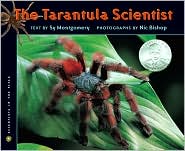
1. Bibliography:
Montgomery, Sy. 2004. The Tarantula Scientist. Boston: Houghton Mifflin Company. ISBN: 0618147993
2. Summary:
In this book, Sy Montgomery follows scientist Sam Marshall as he travels to French Guiana's rainforest on a quest to find out more about tarantulas. The book begins with Sam's quest to find the tarantulas, analyze their habits and living conditions, and ends with his return to the lab to study his findings. Readers not only learn about the research involved but also about tarantulas.
3. Analysis:
Sam Marshall is one out of four or five scientists world-wide who study tarantulas, so this book is an important tool for learning more about tarantulas and the study of them. Sy Montgomery 's challenge is to take detailed scientific research and to make it understandable (and interesting) to kids. She systematically does this in a few simple ways. First, the font is fun. It's not typical font for what kids would see as a "science" textbook. Its thin but sometimes crooked letters almost look like spiders' legs, which sets the feel of the book. Second, the difficult words are accompanied by a phonetic spelling so that kids are not daunted by words such as arachnologist ("ar-rack-NAWL-o-gist"). That is a helpful took to a kid who has not clue how to say the word (and spellcheck has no suggestion for its spelling). The third way is that difficult concepts for younger kids like how the animals are divided into kingdoms, which are further divided, are compared to things like separating clothes--fancy from play, etc. This helps kids relate a harder concept to something they do in their own room.
Because the book follows Sam on an expedition into the rainforest and includes many quotes from the scientist himself, the book clearly demonstrates the passion Sam feels, which gets the reader interested as well when he cracks jokes like, "If life gives you worms, make spider bait," as he is trying to entice a spider out of her burrow. When there's a quote from Sam, saying, "She's a regular eight-legged Martha Stewart," the reader laughs and knows exactly what the spider is like, which connects the text to the reader.
Instead of organizing the book in chronological order of Sam's expedition or by topic, the book seems to jump around from telling about the tarantulas, back to the jungle, then to the research, and then to different types of tarantulas. Comprehension of the facts in the book would be aided by better organization. I could see this book being used as a source for a science paper or science fair project, and better organized (and labeled) chapters would aide in finding specific information.
The pictures are fabulous. The photographer, Nic Bishop, captures the tarantulas in their natural habitat. He captured some wonderful shots of the tarantulas shedding their skin and kicking up dirt in anger. These vivid pictures add to the written description of Sam's findings.
4. Reviews:
Kirkus Reviews: "Bishop's phenomenal photos show spiders mating, shedding their skin, even leaping through the air. It's enough to make Miss Muffet fall in love." (Nonfiction. 8-14)
School Library Journal: "Informative, yes, but even more important, this is a vivid look at an enthusiastic scientist energetically and happily at work, both in the field and in the lab, questioning, examining, testing, and making connections. A treat, even for arachnophobes." -Patricia Manning, formerly at Eastchester Public Library, NY Copyright 2004 Reed Business Information.
5. Connections:
This would be a fabulous book to have in a science classroom. The pictures are great visuals to go along with science lessons. Also, since the pictures are all taken in the natural habitat, students would get to see exactly how the spider lives.

No comments:
Post a Comment